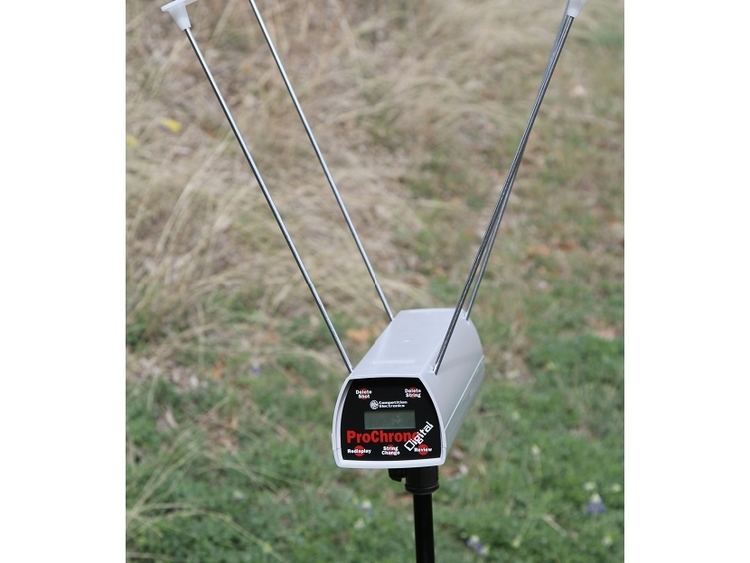 | ||
A gun chronograph is an instrument used to measure the velocity of a projectile fired by a gun.
Contents
History
Benjamin Robins (1707-1751) invented the ballistic pendulum that measures the momentum of the projectile fired by a gun. Dividing the momentum by the projectile mass gives the velocity. Robbins published his results as New Principles of Gunnery in 1742. The ballistic pendulum could make only one measurement per firing because the device catches the projectile. The gun's accuracy also limited how far down range a measurement could be made.
An early chronograph that measures velocity directly was built in 1804 by Grobert, a colonel in the French Army. This used a rapidly rotating axle with two disks mounted on it about 13 feet apart. The bullet was fired parallel to the axle, and the angular displacement of the holes in the two disks, together with the rotational speed of the axle, yielded the bullet velocity.
Ingalls (1882, p. 18) describes Bashforth's chronograph that could make many measurements over long distances:
In 1865 the Rev. Francis Bashforth, M. A., who had then been recently appointed Professor of Applied Mathematics to the advanced class of artillery officers at Woolwich, began a series of experiments for determining the resistance of the air to the motion of both spherical and oblong projectiles, which he continued from time to time until 1880. As the instruments then in use for measuring velocities were incapable of giving the times occupied by a shot in passing over a series of successive equal spaces, he began his labors by inventing and constructing a chronograph to accomplish this object, which was tried late in 1865 in Woolwich Marshes, with ten screens, and with perfect success.The Bashforth screens were made with several threads and series connected switches. A projectile passing through a screen would break one or more threads, the broken thread caused a switch to momentarily (about 20 ms) interrupt a current as the switch arm moved from its weighted position to its unweighted position, and the momentary interruption would be recorded on a paper chart.
Modern chronograph
The modern chronograph consists of two sensing areas called chronograph screens, which contain optical sensors that detect the passage of the bullet. The bullet is fired so it passes through both screens, and the time it takes the bullet to travel the distance between the screens is measured electronically.
The first electronic ballistic chronograph was invented by Kiryako ("Jerry") Arvanetakis in the 1950s. As consulting engineer under contract by NACA (later NASA), he was asked to find a way to accurately measure the velocity of various projectiles fired at hyper-velocities into a variety of engineered materials in anticipation of manned space flight. His first design was an open rectangular frame of square aluminum tubing with a screen of fine copper wire at both ends. Breaking the first wire started charging a capacitor, breaking the second wire stopped it. Measuring the accumulated voltage and knowing the rate of charge the elapsed time could be accurately calculated.
